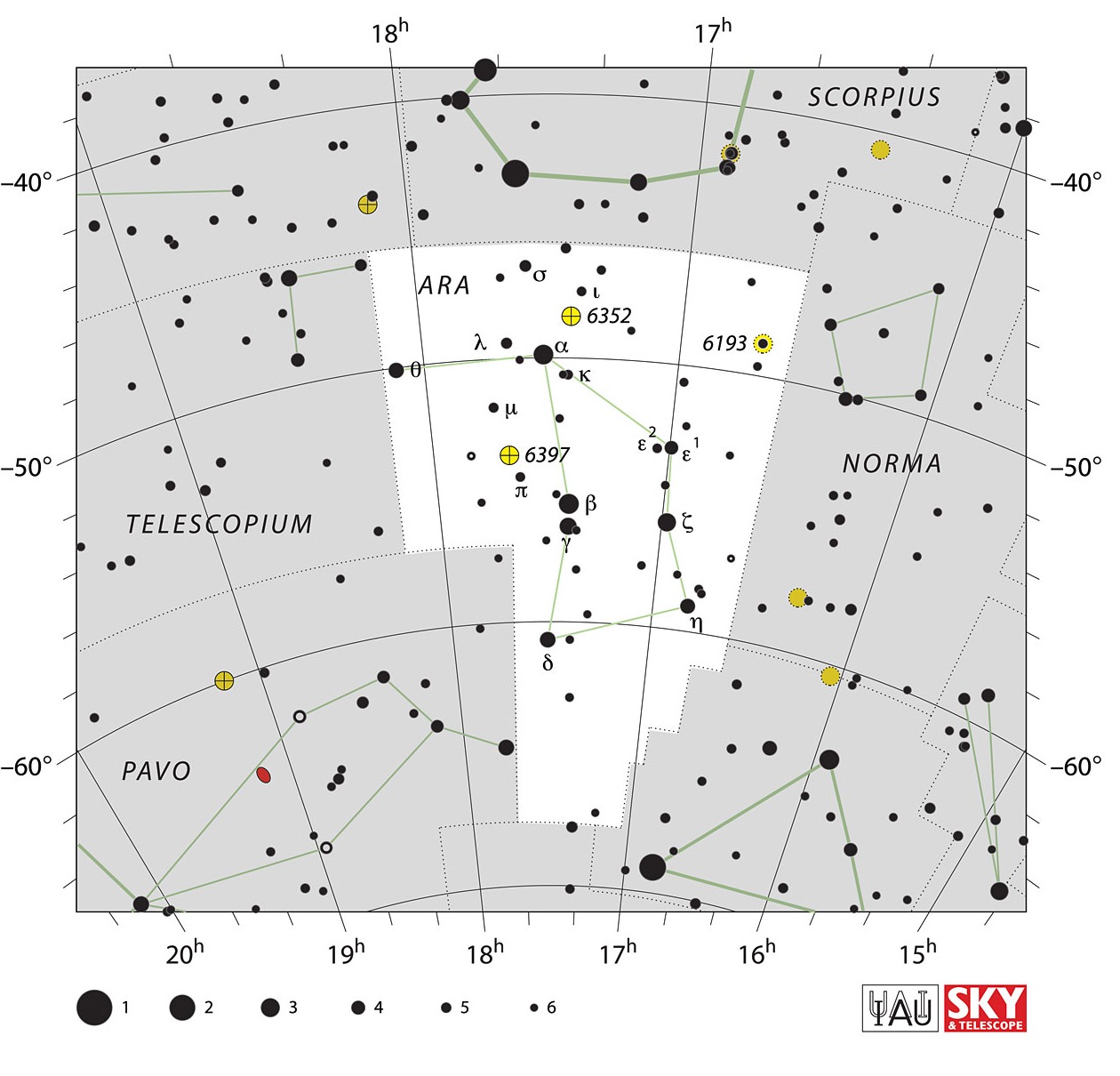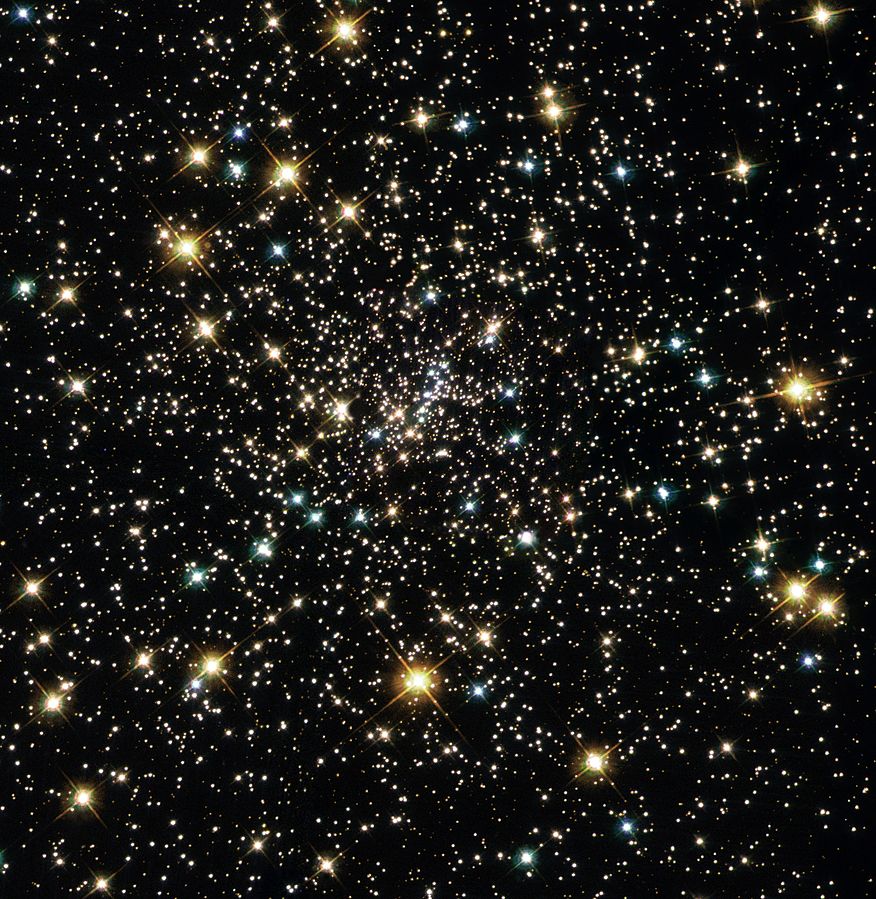Ara is a constellation in the southern celestial hemisphere. The name "Ara" originates from Greek mythology, where it represents the altar used by the gods in their divine ceremonies.
- IAU
- constellation
- astronomy
1. Introduction
Ara, a constellation of the southern celestial hemisphere, stands as a testament to the rich tapestry of mythology and astronomy woven into the night sky. Positioned along the Milky Way, Ara captivates observers with its intricate celestial features and historical significance. Its celestial coordinates lie approximately between right ascension 16h 00m to 18h 00m and declination −50° to −70°, placing it within the realm of the southern celestial hemisphere (Figure 1).

Figure 1. IAU chart of Ara. Source: https://www.iau.org/static/archives/images/screen/ara.jpg. Credit: IAU and Sky & Telescope. Reproduced under CC BY 4.0 license.
The name "Ara" originates from Greek mythology, where it represents the altar used by the gods in their divine ceremonies. This association with ancient mythology imbues Ara with a sense of mystique and grandeur, inviting contemplation of the celestial realm and its enduring influence on human culture.
Ara's celestial coordinates position it amidst a wealth of celestial wonders, including star clusters, nebulae, and distant galaxies. Its location along the Milky Way offers astronomers a unique vantage point to study the structure and dynamics of our galaxy, providing valuable insights into the formation and evolution of cosmic structures.
2. Historical Background
The name "Ara" is derived from Latin, meaning "altar," reflecting its association with the altar used by the gods in Greek mythology.
In ancient Greek mythology, Ara is often linked to the legend of the centaur Chiron, who was known for his wisdom and teachings. According to myth, Chiron sacrificed himself on an altar to free Prometheus, who had been bound by Zeus as punishment for stealing fire from the gods and giving it to humanity. In recognition of Chiron's selflessness and sacrifice, Zeus placed the altar in the heavens as the constellation Ara.
The constellation Ara is also associated with other cultures and civilizations throughout history. In ancient Egypt, Ara may have been linked to the goddess Isis, who was often depicted as a celestial figure overseeing rituals and offerings. Similarly, in Babylonian astronomy, Ara may have represented the god Nusku, the deity of fire and light, symbolizing the divine presence and protection of sacred spaces.
3. Notable Stars in Ara
3.1. Beta Arae
Beta Arae is the brightest star in the constellation Ara. Classified as a blue-white subgiant, Beta Arae shines with a luminosity approximately 620 times that of the Sun and lies approximately 600 light-years away from Earth. Its brightness and spectral characteristics make it a notable feature in the southern celestial sky, contributing to the constellation's distinctive appearance.
3.2. Gamma Arae
Gamma Arae is another notable star in Ara. Classified as a yellow-white dwarf, Gamma Arae shines with a luminosity approximately 17 times that of the Sun and lies approximately 108 light-years away from our solar system. Its relative proximity and spectral properties make it an intriguing target for astronomers studying stellar evolution and galactic structure.
3.3. Delta Arae
Delta Arae is a third-magnitude star located in the constellation Ara. Classified as a blue-white main-sequence star, Delta Arae shines with a luminosity approximately 210 times that of the Sun and lies approximately 143 light-years away from Earth. Its brightness and spectral characteristics make it a prominent feature in the southern celestial sky, adding to the constellation's celestial charm.
3.4. Zeta Arae
Zeta Arae is a binary star system situated in Ara. The primary star is a blue-white main-sequence star, while the companion star is a fainter dwarf star. Zeta Arae shines with a combined luminosity approximately 560 times that of the Sun and lies approximately 500 light-years away from our solar system. Its status as a binary system adds to its astronomical interest and scientific significance.
4. Deep-Sky Objects in Ara
4.1. NGC 6193
NGC 6193 is an open star cluster located in the constellation Ara. It is a young and relatively compact cluster, estimated to be around 3.2 million years old. The cluster contains dozens of hot, massive stars, including several bright blue giants and supergiants. One of the most striking features of NGC 6193 is its association with the nearby emission nebula NGC 6188. The intense ultraviolet radiation emitted by the cluster's hot stars ionizes the surrounding hydrogen gas, causing it to emit light and glow brightly. This interaction between the stars and the surrounding nebula makes NGC 6193 a fascinating object for astronomers studying star formation and the dynamics of stellar clusters.
4.2. NGC 6397
NGC 6397 (also known as Caldwell 86) is a globular cluster located in the constellation Ara (Figure 2). It is one of the closest globular clusters to Earth, lying at a distance of approximately 7,800 light-years. NGC 6397 is estimated to be around 13.4 billion years old, making it one of the oldest known globular clusters in the Milky Way galaxy. The cluster is densely packed with stars, with a total mass estimated to be around 200,000 times that of the Sun. Despite its age, NGC 6397 contains a significant population of low-mass stars known as white dwarfs, which are the remnants of stars that have exhausted their nuclear fuel and reached the end of their evolutionary lifetimes.

Figure 2. A Hubble Space Telescope (HST) image of NGC 6397. Source: https://commons.wikimedia.org/wiki/File:P0321a.jpg. Credit: NASA/ESA and the Hubble Heritage Team (AURA/STScI). Public Domain.
4.3. NGC 6188
NGC 6188 is an emission nebula located in the constellation Ara. It is a sprawling cloud of gas and dust, illuminated by the intense radiation of nearby young stars. The nebula is characterized by its intricate structure and complex filaments of gas and dust, which are sculpted by the stellar winds and radiation pressure from the cluster's hot, massive stars.
NGC 6188 is also known for the presence of several dark nebulae within its boundaries, which appear as patches of obscuring dust silhouetted against the glowing background of the emission nebula. These dark nebulae are regions where new stars are forming, as the dense clouds of gas and dust collapse under their own gravity to form protostars.
